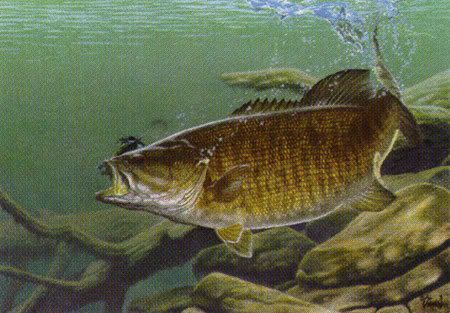
The Smallmouth Bass gives us endless fun and enjoyment each year. Whether it is the aggressive nature of the fish, the peaceful surroundings, the achievement of new fishing goals, the joy of unlocking a new technique, the surprising characterful antics of these terrific game fish, or just being lucky enough to be immersed in their habitat. We keep coming back. Catch and release helps to keep good fisheries good and great fisheries even better.
Here are a few techniques that will help those heroic smallmouth we catch every year survive when released. Thankfully, bass fishing tournaments have popularized catch and release for all Black Bass among American anglers. Many trout fisherman have long tended carefully to their fish. Here are a few things we Smallmouth Bass anglers can do to help out our quarry.
Don't overplay the bass- Putting undue strain on the fish by letting it fight too long can cause a build up of lactic acid that may be harmful to the fish after you release it. Admire the Smallmouth while on the line, but get him in. You'll probably lose less fish too.
Take care to support big fish with two hands- I've seen smallmouth with broken jaws that were clearly caught before. If you hold the fish sideways take care to support it from underneath. Never place too much pressure on the jaw. Grip the fish by the jaw to immobilize it, take care to not let all the weight and pressure fall on that jaw.
Quickly remove hooks with forceps or hook removal tool- Mangled smallmouth result from wrestling hooks out of the fish by hand, tearing flesh and bone in the process. A simple pliers, forceps, or hook remover give you leverage to remove the hook(s) with less overall damage to the bass. A wire cutter allows cutting of hook to aid in removing difficult hooks.
Wet your hands before handling the bass- Dry hands can remove the bass's slime layer which helps protect it from infection.
Consider barbless hooks- A barbless hook allows for easier hook removal from the bass as well as yourself should an accident happen. Just pinch them down with a multi-tool. Also consider removing one or more trebles from cranks and stickbaits. They often end up fouling in a bass's eye.
Take pictures quick- Hold fish in the water mouth upstream while your buddy readies the camera. Have it ready and easy to access ahead of time. If by yourself have the timer function practiced beforehand. You do want a pic of that fish of a lifetime, but you also want it to swim away to catch another day. If you do have to keep him out of the water try to keep it less than a minute or so.
Keep fish in the water pointed upstream- to reduce the stress on it and allow it to breath while you remove the hook or ready for a picture. When you release the bass point him upstream so water flows over the gills, helping to revive the bass.
Avoid touching the gills- Very fragile and vital to the fish surviving.
Cut the line on swallowed baits- If a fish takes a bait into its gullet give up on getting the bait back unless it is clear it will totally obstruct any eating. The bass can still survive if you don't wrench that hook out of its belly. There are techniques out there that allow passing a lure through the gill area, most involve and turning the hook around the other way to force it back the way it entered. Be very careful around the gills of the fish, try not to touch them when removing hooks. Here is a good link detailing the removal of gut hooks on bass: http://www.in-fisherman.com/magazine/articles/if2806_HookRemoval/ . Immediately set the hook to avoid gut hooking! Consider using a cirlce hook.
Practice good livewell techniques- Studies have shown that compared to largemouth, smallmouth bass are more prone to stress and potential mortality when kept in livewells. As such it is important to understand and practice good livewell care and maintenance when smallies are on board. Be sure to use livewell additives (Please Release Me, Rejuvenade, non-iodized salt, etc.) at their recommended dosages. At water temperatures above 70 degrees be sure and run your recirculating pumps continuously for maximum aeration. Also use blocks of ice or cool packs to lower livewell water temperatures 5-8 degrees below lake or river temperatures. Every few hours pump out part of the "old" water from the livewell to eliminate metabolic wastes and add fresh water along with more ice and livewell conditioners. When weigh-in time comes, quickly remove and shuttle your bass to be weighed in dark-colored carry sacks (if available) with plenty of conditioned water. Try and make the process as fast as possible to minimize handling and air exposure, then quickly get your fish returned to the water.
Avoid allowing fish to flop on the ground or deck of a boat-
Use a landing net-The use of a fine-mesh landing net can aid in reducing the amount of time required to land a fish and keep it from thrashing about in shallow water or on the shore.
No comments:
Post a Comment